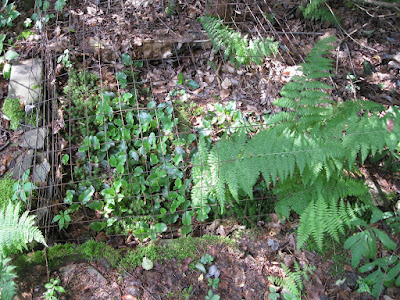Our accumulated knowledge about Arbutus plants at the time was scant at best. We did not know that there are both male and female plants. As luck would have it, three of these plants are male. The small plant growing with moss eventually matured and revealed her gender in flowers that were different from the others. For whatever reason seeds have never been seen in this group.
This is our second attempt to transplant Arbutus. We gathered more knowledge between the two attempts so this group of six plants contains three male plants and three females. These plants have reliably produced seed for several years but no identifiable from seed plants have ever been found. Attempts to start plants from seed have also been unsuccessful. This plant has taught us that it will proceed only at its own pace and no attempt by any man will move it from its natural schedule. The density of these plants is something never seen among wild plants. The pruning by hungry animals may result in open ground among wild plants.
This transplant site was chosen because of its nearness to a White pine tree and the lane. The center of the lane marks the border between three property owners. The right-of-way users have been slow to demonstrate respect for the limits of their use of this land so the stone wall was built to define the location of the end of the lane. To date these plants have suffered no damage from man nor beast.
When we were digging the six plants seen above, an unusual group of five tiny plants was found. They also were removed from the ground and placed along the inside edge of a protective cage. Several years later two plants remained. Both genders were present and seed production followed their relocation and maturity. Here again we have been unable to find any plants from seed despite the more open ground.
The jumble of stones in the background marks the area where fertile river bottom land borders the gravel and stone filled mess that the glacier deposited between the river and the bedrock ridge. Those stones were cleared to produce fields fit for cultivation. Our land contains no river bottom land but the deep soil formed from fallen White pine needles seems to suit these two Arbutus plants. Little time passed between their initial planting and reaching the edge of the cage. We are eager to see if any of the growth beyond the cage survives.
Age has severely limited our attempts to care for much of our gardens. Many areas have become weed filled but the arbutus were planted in the natural soil under pine trees and remain largely weed free. They are basically on their own now. For a short time we will continue to watch these plants and enjoy their unfolding life cycle. Hopefully the next owners of this land will recognize the special nature of these plants and help them along if that is needed.




1 comment:
I remember you talking about planting Trailing Arbutus before. This was one of the first rare plants I learned about. Apparently, the soil up at the Ridges Sanctuary in Door County, Wisconsin, is kind to it, as it grows there, too. Lovely plant. Good luck!
Post a Comment